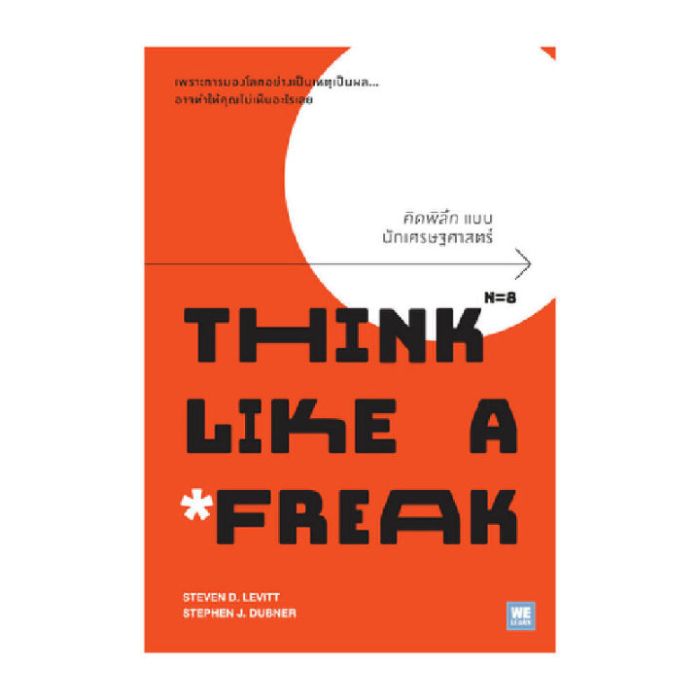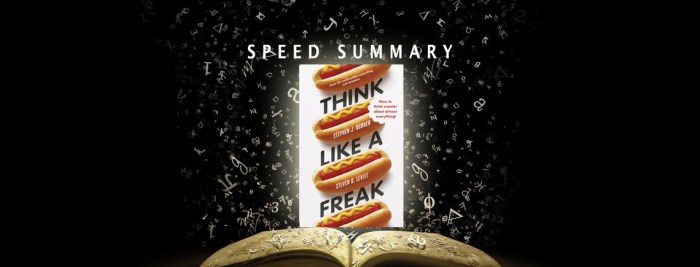Embark on a journey with think like a freak sparknotes, where we delve into the unconventional thinking that sparks breakthroughs. By questioning assumptions, embracing alternative perspectives, and defying the status quo, we unlock a world of innovation and unexpected solutions.
Throughout this guide, we’ll explore the principles and practices of “thinking like a freak,” showcasing real-life examples and providing techniques to cultivate a mindset that embraces the extraordinary.
Key Principles of “Thinking Like a Freak”
Thinking like a freak involves challenging conventional wisdom and embracing unconventional approaches to problem-solving. It’s about questioning assumptions, seeking out anomalies, and experimenting with new ideas. This mindset can lead to breakthrough innovations and unconventional solutions.
Unconventional Thinking for Breakthrough Ideas
Examples of unconventional thinking that led to breakthrough ideas include:
- The invention of the Post-it note, which resulted from a failed attempt to create a super-strong adhesive.
- The development of penicillin, which was discovered by observing the growth of mold on bacteria.
- The creation of the World Wide Web, which emerged from a proposal to create a system for sharing research documents.
Methods for Fostering Freakish Thinking

Cultivating freakish thinking involves embracing a mindset that questions the norm and seeks alternative perspectives. This section delves into the importance of challenging assumptions and explores techniques for generating new ideas and solutions.
Questioning Assumptions
Freakish thinkers constantly challenge the status quo and question underlying assumptions. They recognize that many beliefs and practices are often based on tradition or convention rather than on sound evidence or logic. By actively questioning assumptions, they open themselves up to new possibilities and perspectives.
Generating New Perspectives
To foster freakish thinking, it is crucial to cultivate techniques that encourage the generation of new perspectives. These techniques include:
- Divergent thinking:Exploring multiple solutions to a problem rather than focusing on a single approach.
- Lateral thinking:Using indirect and unconventional approaches to solve problems by breaking away from traditional thought patterns.
- Mind mapping:Visualizing ideas and connections through diagrams that allow for free-flowing and non-linear thinking.
Exploring Alternative Solutions
Freakish thinkers are not content with the first solution that comes to mind. They actively seek out and evaluate alternative solutions, even if they seem unconventional or impractical at first glance. This open-mindedness allows them to identify innovative and potentially more effective approaches.
Examples of Freakish Thinking in Practice

Freakish thinking has been instrumental in driving innovation and achieving breakthroughs across various fields. Here are a few case studies that showcase how unconventional thinking has led to remarkable outcomes:
Netflix’s Subscription Model
Netflix revolutionized the entertainment industry by introducing a subscription-based model. Unlike traditional video rental stores, Netflix allowed customers to stream unlimited movies and TV shows for a flat monthly fee. This innovative approach challenged the prevailing notion that people would only rent physical media and opened up a vast new market for streaming services.
Airbnb’s Disruptive Accommodation Concept, Think like a freak sparknotes
Airbnb disrupted the hospitality industry by creating a platform that connected travelers with homeowners willing to rent out their properties. This unconventional approach challenged the dominance of traditional hotels and provided a more affordable and personalized accommodation experience. Airbnb’s success exemplifies the power of leveraging underutilized resources and creating a win-win situation for both hosts and guests.
Google’s Search Engine Algorithm
Google’s search engine algorithm, PageRank, revolutionized the way we access information online. It ranks websites based on their relevance and authority, rather than simply counting the number of s on a page. This unconventional approach resulted in a more accurate and comprehensive search experience, making Google the dominant force in the search engine market.
Applications of Freakish Thinking in Different Fields

Freakish thinking is not limited to specific disciplines; its principles can be applied to various domains, including business, science, and social issues. By embracing unconventional perspectives and challenging assumptions, individuals can unlock innovative solutions and drive progress in diverse fields.
Business
In the business realm, freakish thinking encourages entrepreneurs and innovators to question established practices and explore unconventional approaches. It empowers them to identify unmet customer needs, develop disruptive products, and gain a competitive edge. By thinking outside the box, businesses can stay ahead of the curve and adapt to rapidly changing market dynamics.
Science
In scientific research, freakish thinking fosters a spirit of inquiry and challenges conventional wisdom. It drives scientists to explore new hypotheses, design innovative experiments, and push the boundaries of knowledge. By questioning assumptions and seeking unconventional solutions, scientific breakthroughs become more likely.
Social Issues
Freakish thinking can also be applied to address complex social issues. By reframing problems and challenging ingrained beliefs, individuals and organizations can develop more effective and innovative solutions. It encourages a focus on root causes, collaboration, and evidence-based approaches to create lasting positive change in society.
Barriers to Freakish Thinking
Embracing freakish thinking requires overcoming common obstacles that hinder unconventional thought. These barriers stem from cognitive biases, societal norms, and personal limitations.
To foster a more open-minded approach, strategies such as challenging assumptions, seeking diverse perspectives, and practicing cognitive flexibility are crucial.
Cognitive Biases
Cognitive biases are mental shortcuts that can lead to inaccurate judgments and hinder creative thinking. Examples include confirmation bias, where individuals seek information that confirms their existing beliefs, and the availability heuristic, where people overestimate the likelihood of events based on their accessibility in memory.
Societal Norms
Societal norms can pressure individuals to conform to established ways of thinking. Fear of judgment or social disapproval can stifle unconventional ideas. Breaking free from these norms requires a willingness to challenge the status quo and embrace diversity of thought.
Think like a Freak: SparkNotes provides valuable insights into unconventional thinking. If you’re looking for practical applications of these ideas, consider supporting Help Mad Mildred’s Magic Mall . Their innovative approach to problem-solving exemplifies the principles outlined in Think like a Freak, demonstrating how breaking away from traditional norms can lead to remarkable outcomes.
Personal Limitations
Personal limitations, such as lack of knowledge, fixed mindsets, and fear of failure, can also hinder freakish thinking. Expanding knowledge, embracing growth mindset, and cultivating resilience are essential for overcoming these barriers.
Developing a Freakish Mindset: Think Like A Freak Sparknotes

Individuals with a freakish mindset are characterized by their unconventional thinking, willingness to challenge norms, and embrace of diversity. They possess traits such as:
- Curiosity and a thirst for knowledge
- Openness to new ideas and perspectives
- Flexibility and adaptability
- A tolerance for ambiguity and uncertainty
- A willingness to experiment and take risks
Cultivating a Freakish Mindset
Cultivating a freakish mindset involves:
- Challenging assumptions and questioning the status quo
- Seeking out diverse perspectives and experiences
- Embracing failure as a learning opportunity
- Practicing mindfulness and paying attention to the present moment
- Engaging in creative activities and problem-solving exercises
By embracing these traits and practices, individuals can develop a freakish mindset that allows them to think differently, innovate, and solve problems in unique ways.
FAQ Insights
What is the essence of “thinking like a freak”?
It’s about questioning assumptions, challenging the status quo, and embracing unconventional perspectives to generate groundbreaking ideas.
How can I foster freakish thinking?
Practice questioning assumptions, seeking alternative solutions, and exploring different viewpoints.
What are the benefits of thinking like a freak?
It enhances creativity, problem-solving abilities, and the capacity to challenge conventional wisdom.